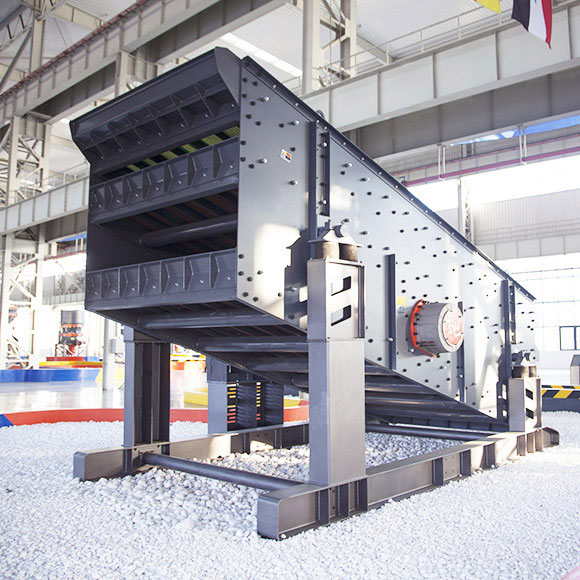Vibrating screener
A vibrating screener is a type of machinery commonly used in various industries to separate materials of different sizes or to remove unwanted particles from a mixture. It is a crucial component in industries such as mining, construction, quarrying, recycling, and agriculture, among others. Vibrating screeners are widely employed to classify aggregates, minerals, and other materials according to size, which is essential for efficient processing and material handling.
Functionality of a Vibrating Screener
The core function of a vibrating screener is to separate materials into different size fractions. These vibrations move the material across the screen surface, allowing smaller particles to pass through the mesh while larger particles remain on top. Depending on the application, the screen’s amplitude, frequency, and angle can be adjusted to optimize performance.

The vibrating screen has multiple layers, with each layer designed to screen materials of specific sizes. For example, in a mining application, large rocks may be screened out at the top layer, while finer aggregates pass through subsequent layers. This separation process enables operators to collect materials of specific sizes, which can then be further processed or used in various production lines.
Components of a Vibrating Screener
The key components of a vibrating screener include:
-
Screen Deck: The surface on which material is placed for screening. It is usually made of wire mesh, with the size of the holes depending on the material being processed and the desired particle size separation.
-
Vibrating Mechanism: This component is responsible for the vibrating motion. Vibrating mechanisms include electric motors, unbalanced exciter motors, or hydraulic systems that generate vibrations.
-
Frame: The frame supports the entire screener structure and holds the screen decks in place. It is made of sturdy materials to withstand heavy vibrations and the forces exerted by the material being processed.
-
Springs: Springs are used to support the vibrating screen, absorbing the impact and reducing the wear and tear on the equipment.
-
Feed Chute: This is where the material is introduced into the vibrating screener. It directs the incoming material onto the screen surface for sorting.
-
Discharge Ports: These are located at the bottom of the screener and serve as outlets for the sorted materials. Each fraction of material is discharged through separate ports, which helps in the efficient collection of different size groups.
Specifications – Technical Data
| Model | Size W×L (mm) |
Number of decks |
Incline (°) |
Mesh Size (mm) |
Max input size (mm) |
Oper.Speed (RPM) |
Double amplitude (mm) |
Capacity (t/h) |
Power (kW) |
| S5X1545-2 | 1500×4500 | 2 | 18(18-25) | 2-70 | 200 | 800-900 | 7-12 | 45-380 | 11 |
| S5X1545-3 | 1500×4500 | 3 | 18(18-25) | 2-70 | 200 | 800-900 | 7-12 | 45-380 | 15 |
| S5X1845-2 | 1800×4500 | 2 | 18(18-25) | 2-70 | 200 | 800-900 | 7-12 | 60-450 | 15 |
| S5X1845-3 | 1800×4500 | 3 | 18(18-25) | 2-70 | 200 | 800-900 | 7-12 | 60-450 | 22 |
| S5X1860-2 | 1800×6000 | 2 | 18(18-25) | 2-70 | 200 | 800-900 | 7-10 | 75-600 | 15 |
| S5X1860-3 | 1800×6000 | 3 | 18(18-25) | 2-70 | 200 | 800-900 | 7-12 | 75-600 | 30 |
| S5X1860-4 | 1800×6000 | 4 | 18(18-25) | 2-70 | 200 | 800-900 | 7-12 | 75-600 | 37 |
| S5X2160-2 | 2100×6000 | 2 | 18(18-25) | 2-70 | 200 | 800-900 | 7-12 | 85-700 | 22 |
| S5X2160-3 | 2100×6000 | 3 | 18(18-25) | 2-70 | 200 | 800-900 | 7-12 | 85-700 | 30 |
| S5X2160-4 | 2100×6000 | 4 | 18(18-25) | 2-70 | 200 | 800-900 | 7-11 | 85-700 | 37 |
| S5X2460-2 | 2400×6000 | 2 | 18(18-25) | 2-70 | 200 | 800-900 | 7-12 | 100-800 | 22 |
| S5X2460-3 | 2400×6000 | 3 | 18(18-25) | 2-70 | 200 | 800-900 | 7-11 | 100-800 | 30 |
| S5X2460-4 | 2400×6000 | 4 | 18(18-25) | 2-70 | 200 | 800-900 | 7-10 | 100-800 | 37 |
| S5X2760-2 | 2700×6000 | 2 | 18(18-25) | 2-70 | 200 | 800-900 | 7-12 | 120-900 | 30 |
| S5X2760-3 | 2700×6000 | 3 | 18(18-25) | 2-70 | 200 | 800-900 | 7-11 | 120-900 | 37 |
| S5X3072-2 | 3000×7200 | 2 | 20(20-25) | 2-70 | 200 | 800-900 | 7-11 | 150-1200 | 37 |
| S5X3075-2T | 3000×7200 | 2 | 20(20-25) | 2-150 | 300 | 800-900 | 7-12 | 180-1800 | 22×2 |
| S5X3075-3T | 3000×7200 | 3 | 20(20-25) | 2-150 | 300 | 800-900 | 7-12 | 180-1800 | 30×2 |
| S5X3680-2T | 3600×7500 | 2 | 21(20-25) | 2-150 | 300 | 800-900 | 7-12 | 225-2250 | 30×2 |
| S5X3680-3T | 3600×7500 | 3 | 20(20-25) | 2-150 | 300 | 800-900 | 7-12 | 225-2250 | 37×2 |
Note:
1, No standard vibrating screen with only one decks.
2, The processing amount listed in the table is based on the dry bulk density graded limestone 1.6t / m3 for a given amount of processing listed as a guide.
